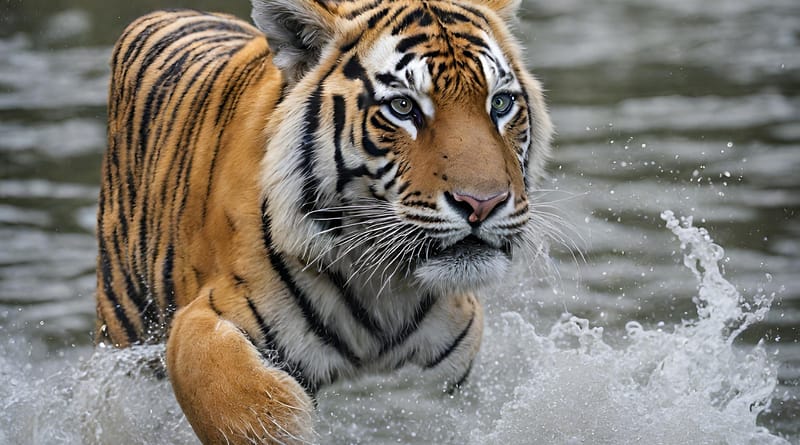Where Do Young Tigers Swim?
Introduction:
Welcome to the captivating realm of young tigers and their aquatic escapades. Have you ever pondered the question, “Where do young tigers swim?” This comprehensive article delves into the intriguing world of these magnificent creatures, unveiling the secrets behind their love for water. From exploring their natural habitats to understanding the significance of swimming in their early years, join us on an extensive journey of discovery. As we unravel the mysteries of where young tigers swim, we’ll also touch upon the developmental benefits of this behavior and shed light on the conservation efforts that play a crucial role in preserving their natural habitats. Whether you’re a wildlife enthusiast or simply curious about the habits of these majestic felines, this exploration promises to provide insights and appreciation for the aquatic adventures of young tigers.
The Aquatic Habits of Young Tigers
Tigers and Water – A Surprising Affinity
Young tigers, like their adult counterparts, exhibit a remarkable affinity for water. Unlike many other big cats, tigers are strong swimmers and are known to enjoy spending time in lakes, rivers, and ponds. Observing these majestic creatures in their aquatic element is a sight to behold, captivating wildlife enthusiasts and researchers alike.
The Natural Habitats of Young Tigers
Tigers are found in various habitats across the globe, from the dense jungles of India to the snowy landscapes of Siberia. Each habitat presents different opportunities for these young felines to indulge in their aquatic instincts. In the lush mangroves of the Sundarbans or the dense forests of Sumatra, young tiger cubs navigate the waters, showcasing their adaptability to diverse environments.
Exploring their natural habitats is crucial to answering the question, “Where do young tigers swim?” Understanding the ecosystems, they inhabit provides valuable insights into their behaviors and the role water plays in their lives.
The Importance of Swimming for Young Tigers
Developmental Benefits of Swimming for Tiger Cubs
Just like human children, young tiger cubs benefit greatly from swimming. It aids in their physical development, muscle strength, and coordination. Swimming provides a playful yet essential aspect of their early years, contributing to their overall well-being.
Researchers have observed that the buoyancy of water reduces the impact on their joints, allowing tiger cubs to engage in physical activities that mimic the stalking and pouncing behaviors crucial for their survival. This developmental aspect of swimming highlights its significance in shaping the future of these young predators.
Where Can You Witness Young Tigers Swimming?
Ever wondered where you can observe these adorable tiger cubs taking a dip? From wildlife reserves to conservation centers, there are specific locations where you can witness this endearing behavior up close. In India, the Bandhavgarh National Park is renowned for its tiger population, offering visitors a chance to witness these majestic creatures in action, including their playful interactions with water.
Conservation efforts around the world have created environments that simulate the natural habitats of tigers, providing opportunities for both education and entertainment. Whether it’s a sanctuary in Thailand or a reserve in Russia, these facilities play a crucial role in raising awareness about tiger conservation while offering a glimpse into the aquatic habits of young tigers.
FAQs About Young Tigers and Their Swimming Habits
Q1: Do All Tigers Enjoy Swimming?
Not all tigers share the same enthusiasm for water. While some species, like the Bengal tiger, are known for their love of swimming, others may be more hesitant. The individual preferences of each tiger, influenced by factors such as their specific habitat and upbringing, contribute to the diversity of behaviors observed in these magnificent creatures.
Q2: At What Age Do Tiger Cubs Start Swimming?
Tiger cubs typically start exploring water at a very young age, often under the watchful eye of their mothers. This early introduction to swimming is a vital part of their upbringing, teaching them essential survival skills. The exact age at which tiger cubs begin to swim can vary, but it is generally observed within the first few months of their lives.
Q3: Is Swimming Instinctive for Tigers?
Yes, swimming is instinctive for tigers. It is believed that their love for water is rooted in their natural habitats, where bodies of water are common. This instinctive behavior serves both practical and developmental purposes, showcasing the adaptability and intelligence of these magnificent creatures.
Understanding the instinctive nature of swimming in tigers provides valuable insights into their evolutionary adaptations and the role water plays in shaping their behaviors.
Q4: What Do Tigers Eat for Food?
The dietary habits of tigers are as intriguing as their swimming behaviors. Tigers are carnivores with a diverse palate, preying on various ungulates such as deer and wild boar. Their diet can also include smaller mammals, birds, and occasionally larger prey such as buffalo. Understanding what do tigers eat for food gives us a comprehensive view of their role in maintaining the delicate balance of ecosystems.
Conclusion:
In conclusion, the question “Where do young tigers swim?” opens the door to a world of wonder and discovery. We’ve explored the natural habitats of these majestic creatures, the developmental benefits of swimming for tiger cubs, and the places where you can witness this endearing behavior firsthand.
As we marvel at the aquatic habits of young tigers, we are reminded of the importance of conservation efforts to protect these endangered species. The intersection of wildlife observation, education, and environmental awareness offers a holistic understanding of the role these creatures play in the delicate balance of our ecosystems.
Whether you’re a wildlife enthusiast, a parent curious about the natural world, or someone intrigued by the mysteries of the animal kingdom, the aquatic adventures of young tigers are a testament to the beauty and complexity of nature. By delving into the realms of wildlife and education, we contribute to the ongoing efforts to preserve the rich biodiversity of our planet.









